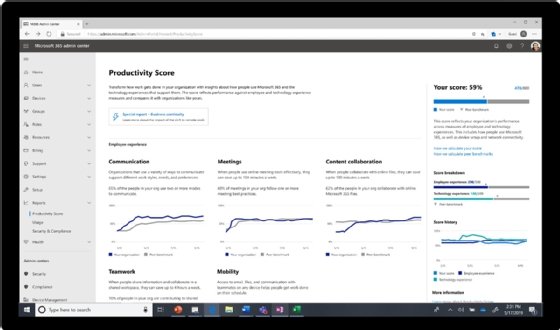
CenturionStudio.it - Fotolia
Microsoft makes Productivity Score useful to tech buyers
Microsoft's Productivity Score update lets an organization's tech buyers monitor, without the help of IT staff, the average performance of employees' PCs and mobile devices.
Microsoft has added endpoint analytics aimed directly at corporate tech buyers to its Productivity Score tool.
The additional page of information, available next week, lets purchasing managers monitor the average performance of workers' PCs and mobile devices. Average boot time and how long it takes employees to sign in are some of the metrics provided.
Productivity Score is a tool within Microsoft 365 that measures how well applications and devices perform and determines how often workers use features like video during Teams meetings. Microsoft launched the software last year for IT staff, but the latest update casts a wider net.
"[This change] should help share information more broadly across organizations," Forrester Research analyst Andrew Hewitt said.
With the new Productivity Score data, tech buyers won't have to request performance reports from IT departments. At the same time, IT staff will still have access to detailed device data to troubleshoot technical problems.
Keeping PCs humming boosts employee productivity, a hot topic among companies managing remote workforces during the pandemic. Microsoft shifted the focus of Productivity Score to software and hardware performance after privacy advocates claimed companies could use the first iteration to track the activities of remote workers.
Changes Microsoft made in December removed end-user names to collect only aggregate data. At the time, the company claimed it never meant for the tool to measure the productivity of individuals.

Nevertheless, monitoring employees at home remains controversial, and privacy advocates will continue to watch future Productivity Score updates.
"You're definitely going to have resistance from employees … who will look at this as someone watching my every move," said Mark Bowker, an analyst at Enterprise Strategy Group (ESG).
Still, many companies remain interested in improving worker monitoring. A November ESG survey of 664 IT decision-makers found 48% felt pressure from executives to increase employee tracking.
Enterprise Strategy Group is a division of TechTarget.
Mike Gleason is a reporter covering end-user computing topics such as desktop management. He previously covered communities in the MetroWest region of Massachusetts for the Milford Daily News, Walpole Times, Sharon Advocate and Medfield Press. He has also worked for newspapers in central Massachusetts and southwestern Vermont and served as a local editor for Patch. He can be found on Twitter at @MGleason_TT.







